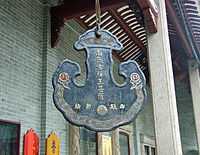Temple of the Six Banyan Trees
| Temple of the Six Banyan Trees 六榕寺 | |
|---|---|
|
The Temple's pagoda | |
| Information | |
| Founded | 537 AD |
| Address | Guangzhou, Guangdong |
| Country | People's Republic of China |
| Coordinates | 23°07′41″N 113°15′38″E / 23.128185°N 113.260642°E |



The Temple of the Six Banyan Trees (Chinese: 六榕寺; pinyin: Liùróng Sì; Wade–Giles: Liu4-jung2 Szu4) is an ancient Buddhist temple originally built in 537 in the Liang dynasty in Guangzhou, southern China.
The temple's proximity to foreign consulates in Guangzhou has made it a regular destination for families participating in the international adoption of children from China. Typically families receive blessings for their newly adopted children at this temple in front of the statue of Kuan Yin.
History
The Temple of the Six Banyan Trees was originally called the Baozhuangyan Temple, but during the Northern Song dynasty, a writer called Su Shi wrote the inscription Liu Rong (Six Banyan Trees) because of the six banyan trees he saw there and it has since been called the Temple of the Six Banyan Trees.
The temple was burned down and rebuilt in the Northern Song dynasty. Flower Pagoda, the main structure of the temple, was built in 1097, and was named for its colorful exterior. The Flower Pagoda once had a square base in its architecture, but was given an octagonal shaped base after it was rebuilt in 1097. It was rebuilt again in 1373 AD after another fire in the early Ming dynasty period, and restored in 1900.
See also
External links
| Wikimedia Commons has media related to Temple of the Six Banyan Trees. |
- Temple of the Six Banyan Trees at travelchinaguide.com
- http://www.nudieman.com/anrg/flower_pagoda.htm (Description and some pictures)
| ||||||||||||||||||||||||||||
